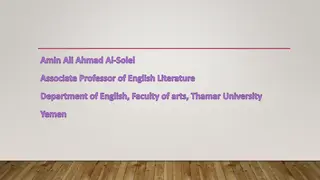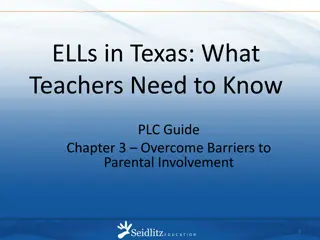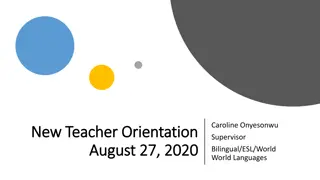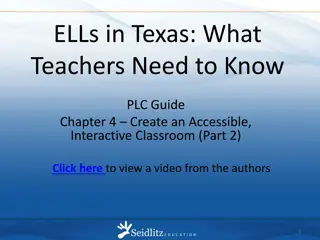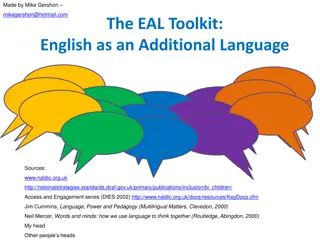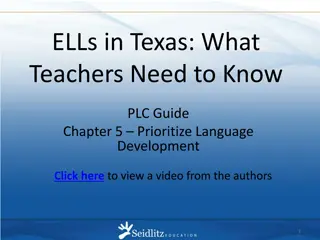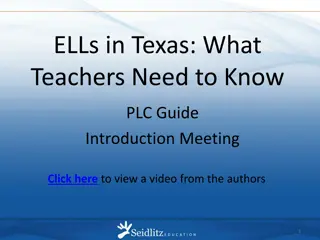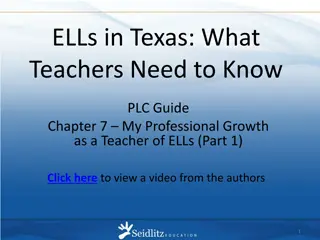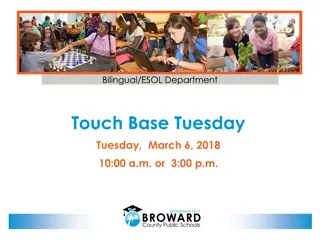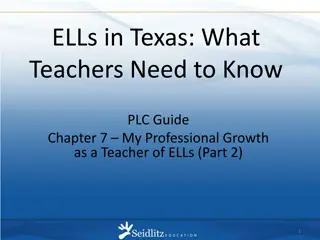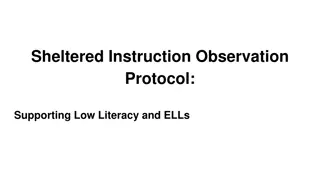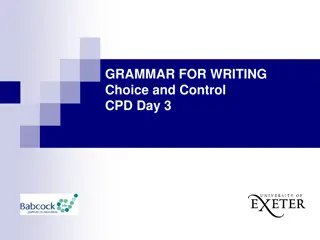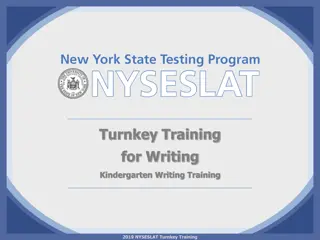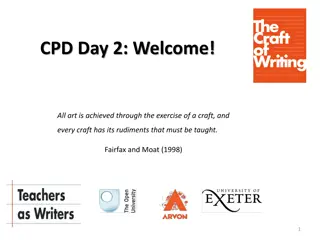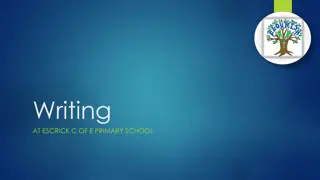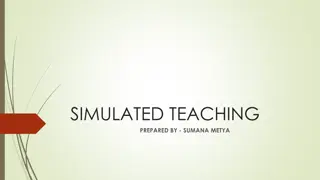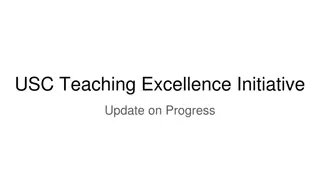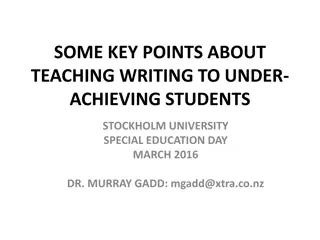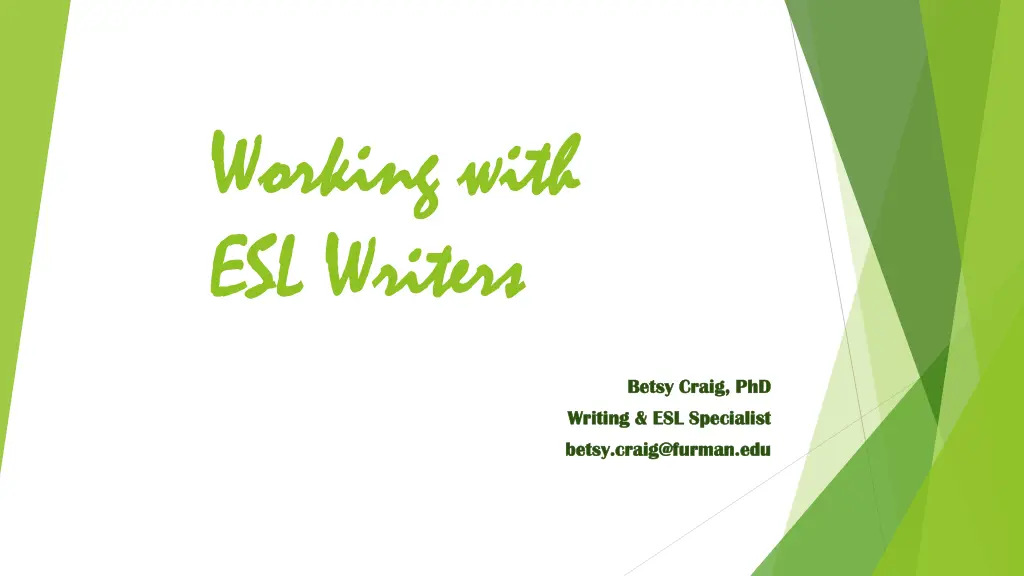
Understanding and Supporting ESL Writers: Tips and Strategies
Learn how to work effectively with ESL writers, understand common challenges they face, top grammar mistakes, Chinglish errors, and practical tips to support them in academic writing. Explore strategies such as early assessments, referral options, providing feedback, and setting clear expectations to enhance their writing skills.
Download Presentation

Please find below an Image/Link to download the presentation.
The content on the website is provided AS IS for your information and personal use only. It may not be sold, licensed, or shared on other websites without obtaining consent from the author. If you encounter any issues during the download, it is possible that the publisher has removed the file from their server.
You are allowed to download the files provided on this website for personal or commercial use, subject to the condition that they are used lawfully. All files are the property of their respective owners.
The content on the website is provided AS IS for your information and personal use only. It may not be sold, licensed, or shared on other websites without obtaining consent from the author.
E N D
Presentation Transcript
Working Working with ESL Writers ESL Writers with Betsy Craig, PhD Betsy Craig, PhD Writing & ESL Specialist Writing & ESL Specialist betsy.craig@furman.edu betsy.craig@furman.edu
What to Expect from ESL Students May lack critical thinking skills (deference to authority) May lack academic (specialized/Latinate) vocabulary May want to be called on to participate in class discussions May not leave the classroom before the teacher May repeat certain grammatical errors (fossilization) May overgeneralize (based on anecdotal experience) May express a strong, absolute stance in writing (lack of hedging) May lack the ability to evaluate good sources/websites May need low-stakes environments to participate (groups) May have no understanding of information ownership May have difficulty understanding oral instructions
Top Grammar Mistakes Native Speakers Verb tense consistency Agreement: pronoun/antecedent Agreement: subject/verb Punctuation: comma, run-on, frag Possessive apostrophe Capital letters Dangling modifier Missing word Vague pronoun reference Quotation integration Spelling Wrong word (informal register) ESL Students Function words: art, prep, pronouns S/V agreement (3rdsingular -s) Punctuation: clause vs. phrase Word forms (inflection/derivational) Verb tense: present, past, future Verb aspect: simple, perf, progressive Voice: active vs. passive Helping verbs: modals & be, have, do Faulty parallelism Wrong word (transliteration)
Chinglish Most frequent academic vocabulary errors: Word Form NOUN NUMBER -s VERB 3PS -s PREP + V-ing (gerund) BE + V-en (passive voice) TO + V (infinitive) MODAL + V HAVE + V (perfect aspect) Verb Tense Consistency
What to Do Conduct early in-class writing assessments (1stday of class) Speak slowly, at a good volume, and near ELLs Referral to me in CAS for editing assistance Referral to WML Peer Consultants for brainstorming, organizing, revision Referral to Reference Librarians for research assistance Use direct, coded grammar error feedback Do explicit, in-class textual analysis (teach noticing of discourse and grammatical structures in academic readings in your discipline) Provide examples of good AND bad writing in your content area At each new assignment, make explicit what they are NOT to do: Use essay-selling websites Copy and paste from a website Get help from friends
Scaffold the Writing Process Preview high-frequency, content-area vocabulary Determine type of essay/assignment Brainstorm: Focus on topic, then thesis as moving target Organize/Outline: Focus on logical development/support Practice summarizing & citation styles in class 1stDraft with in-text citations: Focus on clarity & structure Edit for grammar problems Require individual consultations (Be specific & targeted) 2ndDraft with error correction & further development Peer review & more instructor input Revise, revise, revise 3rdDraft for a final grade
20-minute Writing Workshops Topic vs. Title vs. Thesis Evaluating websites Paraphrasing/Summarizing Distinguishing fact from opinion Organizing subtopics Parsing an academic reading Achieving cohesion with pronouns/conjunctions Hedging (tempering stance) Structuring argumentative writing Academic vocabulary (morphology) Stylistic devices
Averting Plagiarism Do early and frequent in-class writing diagnostics Give short writing assignments due every week Model accurate, responsible citation behavior Discourage Wikipedia usage, except for help in finding original references Demonstrate how easy it is for instructors to check the web for plagiarism Remind students that you will be checking for plagiarism with Turnitin Show students websites that sell essays as inappropriate for use in research Ask a research librarian to model good search behavior on the website Do in-class exercises on paraphrasing and summary writing Review academic honesty policy and the violation process Assure students that their own writing is good enough Report every instance of substantiated, intentional plagiarism
ACCOMMODATIONS Ask ELLs to sit in the front of the classroom Provide simple directions both orally and in writing Pair students to check work, notes, and understanding (Do not provide a note-taker) Write key points on the board Allow tape recordings of lectures Make your thinking processes explicit Break long lessons into shorter activities Allow English-English dictionaries on exams Model reference-consulting behavior Allow extra time for in-class writing Give frequent quizzes Praise students for in-class participation
Reading Instruction Give some attention to academic vocabulary Assign some lighter, yet academic, readings in your discipline (Trade Magazines) Show students how to preview an academic reading, i.e. their textbook Show students how to read an academic text Point out what you regard as (in)effective writing Encourage reading for pleasure
WORD CLOUD betsy.craig@furman.edu
Linguistic Characteristics of Academic Prose No contractions Third-person pronouns Latinate (formal) vocabulary (long words) Nominal density (mostly plural) Nominalizations: -tion, -ity High frequency of noun cohorts: art, prep, pron, adj Simple, present tense verb phrases Non-lexical verbs: be, have, do Reporting verbs: states, contends, claims, explains, etc. Passive voice (reasons for use) Cohesive devices: prepositional phrases, conj, pron Hedging: perhaps, may be, could, etc. Prepositional phrases used for signaling


